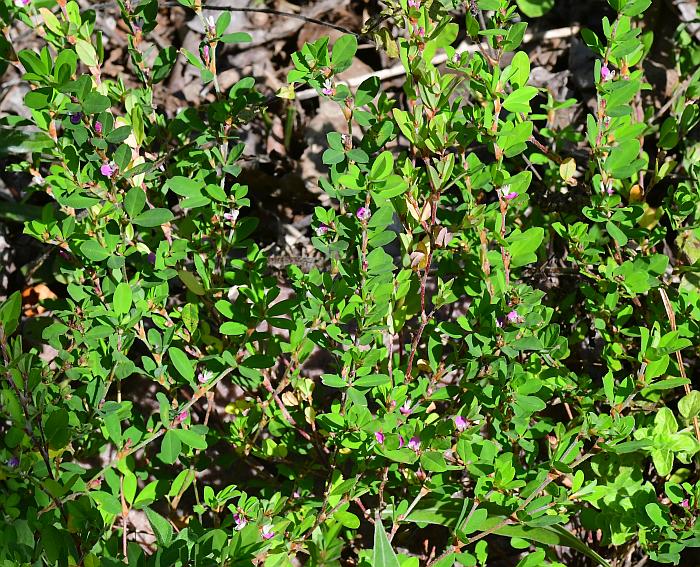Kummerowia striata (Thunb.) Schindl.
Japanese Clover

Introduced
CC = *
CW = 3
MOC = 44
© SRTurner
Kummerowia striata (Thunb.) Schindl.Japanese Clover | |
 |
Introduced CC = * CW = 3 MOC = 44 |
© SRTurner |
|
Family - Fabaceae/Faboideae Habit - Annual forb.
Stems - Prostrate, spreading, or ascending, to 50 cm, pubescent with stiff, recurved or backward-pointing, usually appressed hairs.
Leaves - Alternate, petiolate, stipulate, trifoliate. Lower and median leaves with petioles 1-4 mm long, these sparsely to moderately pubescent with recurved or backward-pointing hairs. Stipules of lower and median leaves 3-6 mm long, equaling or exceeding the accompanying petioles. Leaflets 5-20 mm long, obovate to narrowly elliptic or narrowly oblong, narrowed or sometimes rounded at the base, rounded to shallowly notched at the tip, the upper surface glabrous, the undersurface glabrous or sparsely to moderately pubescent with inconspicuous appressed hairs, the margins with inconspicuous appressed hairs.
Inflorescences - Axillary, solitary flowers or clusters of 2-5 flowers, each subtended by 3-4 minute papery bracts.
Flowers - Calyces 1.6-2.2 mm long, slightly shorter in cleistogamous flowers, the tube about as long as the lobes, glabrous or sparsely hairy along the margins. Corollas papilionaceous, 4.5-6.0 mm long, shorter in cleistogamous flowers, pink, purple and white.
Fruits - Modified 1-seeded legumes 2.5-4.0 mm long, flattened, obovate to elliptic in outline, short-tapered to a beaklike tip, the surfaces with an inconspicuous network of nerves, the persistent calyx covering 1/2-4/5 of the fruit. Seeds 1.5-2.0 mm long, somewhat flattened, the surface smooth, brown to black, shiny.
Flowering - July - October. Habitat - Glades, rocky upland prairies, forest openings, pastures, fields, roadsides, railroads, lawns, disturbed open places. Origin - Native to Asia. Lookalikes - K. stipulacea, Lespedeza repens, Lespedeza procumbens. Other info. - This plant has been a favored forage crop amongst horse and cattle ranchers. It was the first deliberately introduced species of Kummerowia, being brought to the U.S. from Japan in 1846. Like many introduced species, it has grown rampantly and become a common weed of lawns and disturbed ares. It is now found across the eastern half of the U.S. with the exception of a few northern states. It is recognized by its low habit, trifoliate leaves with prominent papery stipules, and small white and purple flowers. It closely resembles K. stipulacea, but can be distinguished from that species by stem hairs which are retrorse (backward-pointing), and by a lack of conspicuous ciliate hairs on the leaflet margins. Fruiting specimens have fruits which are more than half covered by the persistent calyx. The plant has both conspicuous chasmogamous flowers and diminutive cleistogamous flowers, both of which are fertile. Open flowers are actually quite striking up close but the plant is basically too small to have much ornamental value. Photograph taken off 500th Rd., Johnson County, MO., 9-2-99, and in Notasulga, AL., 9-24-04 (DETenaglia); also near Labadie, Franklin County, MO, 9-1-2021 and 9-14-2021, and at Don Robinson State Park, Jefferson County, MO, 9-10-2021 (SRTurner). |